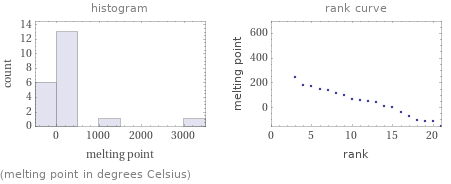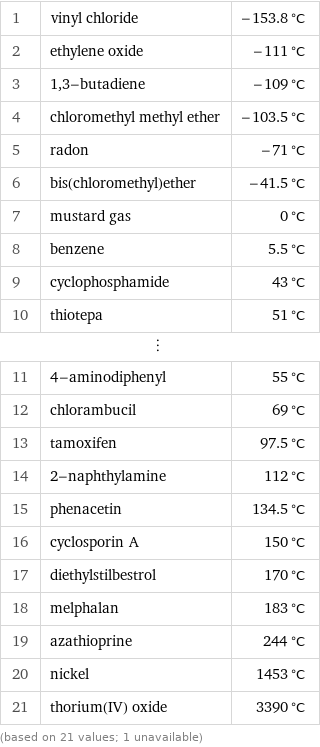Input interpretation

chemical carcinogens | melting point
Summary

median | 55 °C highest | 3390 °C (thorium(IV) oxide) lowest | -153.8 °C (vinyl chloride) distribution | | (based on 21 values; 1 unavailable)
Entity with missing value

aflatoxin
Distribution plots

(melting point in degrees Celsius)
Melting point rankings

1 | vinyl chloride | -153.8 °C 2 | ethylene oxide | -111 °C 3 | 1, 3-butadiene | -109 °C 4 | chloromethyl methyl ether | -103.5 °C 5 | radon | -71 °C 6 | bis(chloromethyl)ether | -41.5 °C 7 | mustard gas | 0 °C 8 | benzene | 5.5 °C 9 | cyclophosphamide | 43 °C 10 | thiotepa | 51 °C ⋮ | | 11 | 4-aminodiphenyl | 55 °C 12 | chlorambucil | 69 °C 13 | tamoxifen | 97.5 °C 14 | 2-naphthylamine | 112 °C 15 | phenacetin | 134.5 °C 16 | cyclosporin A | 150 °C 17 | diethylstilbestrol | 170 °C 18 | melphalan | 183 °C 19 | azathioprine | 244 °C 20 | nickel | 1453 °C 21 | thorium(IV) oxide | 3390 °C (based on 21 values; 1 unavailable)
Unit conversions for median melting point 55 °C

328 K (kelvins)

131 °F (degrees Fahrenheit)

591 °R (degrees Rankine)

44 °Ré (degrees Réaumur)

36 °Rø (degrees Rømer)
Comparison for median melting point 55 °C

35 °C above conventional US room temperature (68 °F)

35 °C above temperature at STP (standard temperature and pressure), using the National Institute of Standards and Technology convention (20 °C)

39 °C above temperature at STP (standard temperature and pressure), using the US customary convention (60 °F)
Corresponding quantities

Thermodynamic energy E from E = kT: | 28 meV (millielectronvolts)

Blackbody energy flux Φ from Φ = σT^4: | 658 W/m^2 (watts per square meter)

Approximate luminous exitance from a planar blackbody radiator perpendicular to its surface: | 5.4×10^-19 lx (lux)
Nearest corresponding gas marks for median melting point 55 °C (degrees Celsius)

| temperature | usage thermostat 2 | 60 °C | France (actual measurements may vary)